
The Bubonic Plague has been identified in the skeletons of two people who were buried side by side in Russia… 3,800 years ago.
The remarkable discovery shows one of the world’s most feared diseases has been wiping out humans since the Bronze Age – about 1,000 years earlier than thought.
It also sheds fresh light on the early stages of the evolution of Yersinia pestis – the notorious killer bug that caused the Black Death.
Scientists found by this time it was already able to cause the bubonic form spread through fleas.
The victims – the oldest confirmed cases of Bubonic Plague to date – were members of the Srubnaya culture.
These people were known for the timber framed graves they peppered throughout the flat grasslands, or steppes, of Russia.
They brought with them metallurgy and animal herding skills.
They are also believed to be responsible for the mysterious Proto-Indo-European ancestral tongue from which 400 languages spring, including English.
The researchers analysed nine individuals from tombs on the outskirts of Samara, a southern city on the Volga River which today is home of Russia’s space programme.
Two were determined to have been infected with Y. pestis at the time of their deaths. They were buried together in a single grave.
Palaeopathologist Dr Kirsten Bos, of the Max Planck Institute for the Science of Human History, Jena, Germany, said: “Both individuals appear to have the same strain of Y. pestis.
“And this strain has all the genetic components we know of that are needed for the bubonic form of the disease.
“So plague, with the transmission potential that we know today, has been around for much longer than we thought.”
The study published in Nature Communications said the strain is the oldest sequenced to date that contains the virulence factors considered characteristic of the Bubonic Plague.
It is the ancestor of the strains that caused the Justinian Plague – the first recorded pandemic in 541 AD which killed more than 25 million people – and the Black Death that claimed 50 million lives in Europe between 1348 and 1350.
Bubonic Plague has triggered a string of deadly pandemics including ones that swept through China in the late 1800s and caused 10 million deaths.
The disease continues to affect populations around the world today.
But despite its historical and modern significance, the origin and age of the disease are not well understood.
In particular, exactly when and where Y. pestis became able to kill humans through a bite from a flea that carries it has been unclear.
Recent studies of ancient Y. pestis genomes identified its earliest known variants, dating to the Late Neolithic and Early Bronze Age.
But these did not show the genetic signatures that helped it survive in fleas which act as the main vectors that transmit the disease to mammals – including humans and rats.
The researchers used the data collected in combination with previously sequenced Y. pestis strains.
This enabled them to calculate their newly identified lineage is around 4,000 years old – pushing back the proposed age of the bubonic plague by 1,000 years.
First author Dr Maria Spyrou, also of the Max Planck Institute for the Science of Human History, said: “Our Y. pestis isolates from around 4,000 years ago possessed all the genetic characteristics required for efficient flea transmission of plague to rodents, humans and other mammals.”
The study suggests there were at least two plague lineages circulating at the same time during the Bronze Age and that they may have encompassed different transmission and virulence characteristics.
Explained senior author Dr Johannes Krause, a biochemist at the Max Planck Institute for the Science of Human History, said: “Whether the lineages were equally prevalent in human populations, and the extent to which human activities contributed to their spread, are questions that would need further investigation.”
He added: “Additional Bronze Age and Iron Age plague genomes could help pinpoint key events that contributed to the high virulence and spread of one of humankind’s most notorious pathogens.”
https://www.thelondoneconomic.com/news/hominid-species-that-existed-around-the-time-of-the-first-ever-humans-had-a-similar-but-much-smaller-brain/14/05/
https://www.thelondoneconomic.com/news/rocks-near-dried-out-lakes-may-show-life-really-did-emerge-on-mars-say-scottish-scientists/29/05/